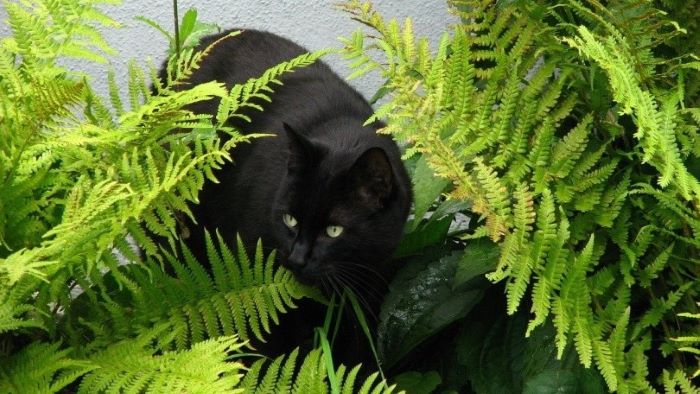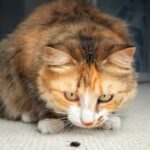Beautiful ferns may give a touch of elegance and greenery to your house or garden. However, if you have a cat, you might be concerned about whether ferns are secure for your pet. Can cats touch or eat ferns without being hurt? Or should ferns be completely avoided because they are harmful to cats?
The solution is not that easy because not all ferns are the same. While certain ferns are safe for cats to consume, some can be poisonous or even fatal. We will look at the many fern species and how they affect cats in this article.
In this article, you will have a better understanding of whether or not ferns are hazardous to cats, as well as how to keep your cat safe and healthy around these plants.
How Can I Tell If a Fern Is Toxic or Not?
First of all, you should be aware that not all plants that resemble ferns actually are ferns. Despite being members of distinct families or genera, several plants have stems or leaves that resemble ferns. Even though these plants contain the word “fern” in their names, they are not actually ferns.
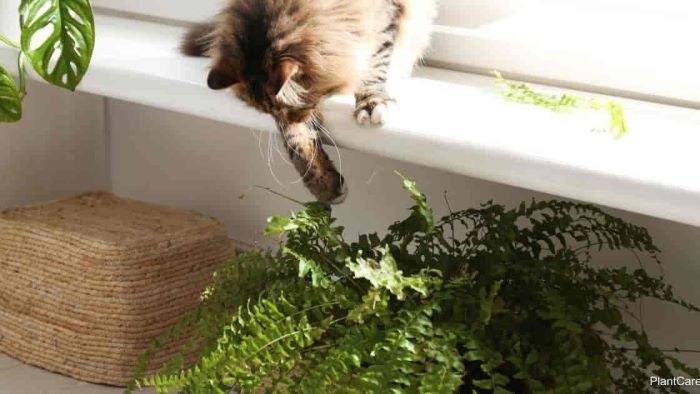
True ferns: The Polypodiopsida class of plants includes true ferns, which typically have fronds that are divided into pinnae-sized leaflets. True ferns include, for example:
- Boston fern
- Sword fern
- Mother fern
- Carrot fern
The ASPCA advises against feeding or handling these genuine ferns to cats. They are not toxic or hazardous to cats, but if consumed in big quantities, they could induce a slight stomach upset[1].
False ferns: But certain plants that resemble ferns but aren’t real ferns can be poisonous or hazardous to cats. These are a few examples of these plants:
- Asparagus fern
- Foxtail fern
- Sprengeri fern
- Lace fern
- Emerald fern
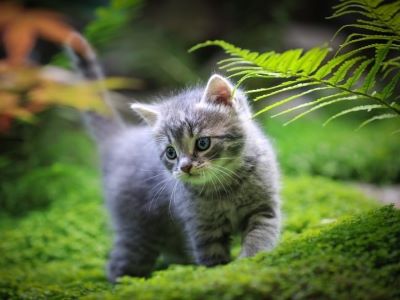
These plants are toxic or harmful to cats, according to the ASPCA. They can cause various symptoms, such as vomiting, diarrhea, skin irritation, depression, low blood pressure, tremors, seizures, or even death.
Because of this, it’s critical to know what kind of plant you have before introducing it to your cat.You can look up the name and picture of your plant online and check to see if it is harmful using sites like the ASPCA website. For further information, you can also speak with your neighborhood zoo or veterinarian.
What Are the Signs and Symptoms of Fern Poisoning in Cats?
Depending on the kind and quantity of hazardous plants your cat eats or contacts, they may exhibit a variety of various signs and symptoms. Among the typical warning signs and symptoms of feline fern poisoning are:
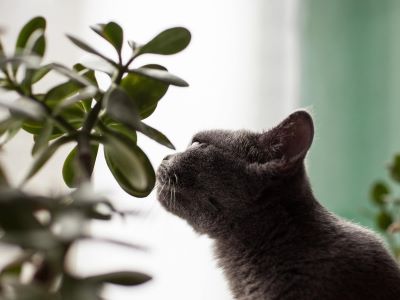
- Vomiting
- Diarrhea
- Loss of appetite
- Depression
- Skin irritation
- Swelling
- Ulcers
- Low blood pressure
- Tremors
- Seizures
Depending on the kind and quantity of plant consumed or contacted, these signs and symptoms may vary in intensity and length of time. A few hours or days later, some plants may cause minor, self-limiting effects. Others may result in serious, potentially fatal symptoms that demand prompt veterinarian care.
What Should I Do If My Cat Eats or Touches a Toxic Fern?
If you suspect that your cat has eaten or touched a toxic plant that looks like a fern, you should act quickly and follow these steps:
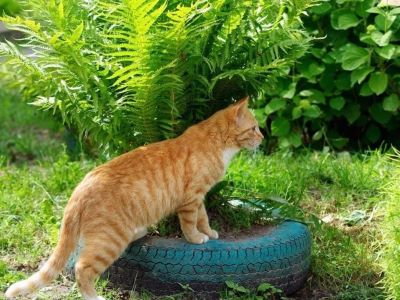
- Remove any remaining plant material from your cat’s mouth, skin, or fur.
- Identify the plant if possible. Take a sample or a picture of the plant and its label if available.
- Call your veterinarian or the ASPCA Animal Poison Control Center for advice. They will tell you what to do next and whether you need to bring your cat to the clinic or not.
- Follow the instructions given by your veterinarian or the poison control center. They may ask you to induce vomiting, give activated charcoal, or administer fluids or medications to your cat.
- Monitor your cat for any signs and symptoms of fern poisoning and report any changes to your veterinarian or the poison control center.
- Keep your cat away from any toxic plants in the future and prevent them from accessing them.
How Can I Prevent My Cat From Getting Into Contact With Toxic Ferns?
Avoiding having poisonous plants that resemble ferns in your home or garden in the first place is the best method to stop your cat from coming into contact with them. You should either get rid of any of these plants you have or keep them out of your cat’s reach if you do. You can prevent your cat from visiting these plants by using deterrents, barriers, or repellents.
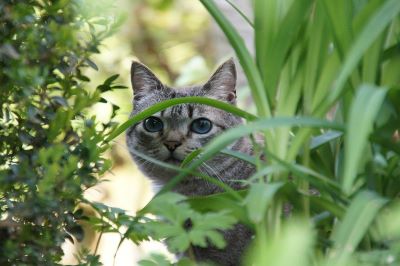
Providing your cat with nutritious substitutes is another approach to keep them from coming into contact with poisonous plants that resemble ferns. You can raise some plants that are safe for cats to snack on, such as catnip, cat grass, mint, or parsley. Additionally, you can give your cat some interactive activities, treats, or toys to keep them happy and occupied.
FAQ
Are all ferns toxic to cats?
Some fern species can be poisonous to cats, though not all of them are. The type of fern you have must be known in order to determine whether it is poisonous to cats.
Which ferns are toxic to cats?
The Asparagus fern, Bracken fern, and Lace fern are a few ferns that are thought to be harmful to cats. These plants can upset a cat’s stomach and lead to numerous health problems.
What happens if my cat Eats a toxic fern?
Your cat may exhibit signs like vomiting, diarrhea, lethargy, and breathing difficulties if they eat a toxic fern. It may cause more significant issues in extreme circumstances.
How can I keep my cat safe from toxic ferns?
Avoid keeping poisonous plants in your house or garden to keep your cat safe. Choose non-toxic substitutes that are safe for cats, such as Boston fern, Maidenhair fern, or Bird’s Nest fern.
Conclusion
Beautiful ferns may give a touch of elegance and greenery to your house or garden. However, you must be cautious about the ferns you have and how they effect your cat if you have one. While certain ferns are safe for cats to consume, some may be toxic or dangerous.
If you wish to keep ferns in your house or garden, only pick real ferns that cats can’t eat or handle. Before exposing your cat to a plant, you should also determine what kind it is. Any plants that resemble ferns but are not actual ferns should be avoided since cats may be poisoned or harmed by them.
Act immediately and take the actions we stated above if your cat consumes or comes in contact with a poisonous plant that resembles a fern. Remove any remaining plant matter from your cat’s mouth, skin, or fur; identify the plant, if possible; contact your veterinarian or a poison control center for advice; heed their recommendations; keep an eye out for your cat’s fern poisoning symptoms; and avoid exposing your cat to toxic plants in the future.
References:
- Whitehead, K., Cortes, Y., & Eirmann, L. (2016). Gastrointestinal dysmotility disorders in critically ill dogs and cats. Journal of Veterinary Emergency and Critical Care, 26(2), 234–253. Wiley Online Library

